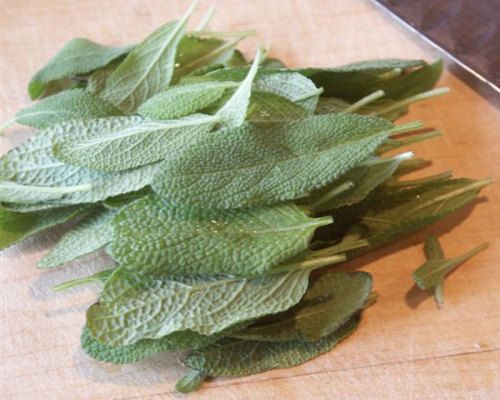
I consider the robust herbs to be the strong-flavored woody-stemmed perennials such as oregano, rosemary, sage, savory, thyme. And of course garlic would have to be included here. By smelling and tasting these perennial plants, you will be inspired to use them to flavor your winter recipes. Hopefully, you will use these flavorful herbs in combination with foods of the season to create some of the warming winter dishes that are some of my favorites.
Sage (Salvia officinalis)
 |
|
| A sage plant in bud. | |
 |
|
| Sage can be grown indoors in pots. These plants are in need of pruning and transplanting. |
The first herb I will discuss is sage; which is an herb that most people don’t cook with very often. If you ask the average person what they use sage in, the reply is usually (1) stuffing and (2) sausage. I think that most people don’t like it because of its camphor-like aroma. I find it to go wonderfully well with root vegetables, winter squash, potatoes, eggs and cheese, grains and beans, breads, and apples and pears—all cold-weather season foods.
The associations of the meanings of sage and its homonym are linked in Latin as in English. The herb’s name is from salvere “to be well,” “to save,” while the word relating to wisdom is from sapere “to taste,” “to know.” It is certainly wise to know sage well because, in addition to its traditional uses in sausages and with poultry, game, and liver, sage can add a rich and graceful note to vegetables, breads, and sweets.
Medicinal uses of sage
Sage’s culinary use with rich dishes probably came from its reputation as a digestive. It was very highly held as a medicinal plant by the Greeks and Romans. Its principal use was as a calmative for the stomach and nerves. Regular use of sage tea was said to confer an even disposition to excitable natures and a healthy old age to everyone. Sage was especially recommended to older persons as it was believed to restore ailing memory and banish melancholy and depression. Swiss peasants and American Indians used sage as a dentifrice, first chewing a few leaves, then brushing the gums with a twig. In England, tea made with the leaves of clary sage, Salvia sclarea, was the common beverage until Chinese tea began to be imported. The English, in turn, introduced sage tea to the Chinese, who would exchange up to five bushels of Chinese tea for one bushel of sage. This tea is still drunk in China today.
Sage in the kitchen
 |
|
| Sage adds a pungent kick to Pasta e Fagioli. Get the recipe… |
Sage is much respected culinarily in England and Italy, where most country gardens have a sage bush, often 15 years or older. The flavor from good sage stock does not deteriorate with age, but sage varies in flavor as much as some of the more delicate herbs, depending on its soil and weather conditions. Dalmatian sage from Yugoslavia is esteemed because the camphor odor is less pronounced than in sage grown in different climates. This aroma is also milder in the fresh leaf. The flavor of fresh sage has decided lemon rind tones over resin. The lemon flavor recedes and the camphor, and a pleasant muskiness similar to silage, comes forward when sage is dried.
Common sage seems to keep its aroma and flavor through cooking and drying. Dwarf sage, white-flowered sage, and purple sage, are all handsome varieties of common sage, with good flavor and aroma. Pineapple sage, fruit-scented sage, and mint-leaved sage all belong to the sage family and have the familiar muskiness, with the added aromas that their names suggest. They lose a bit of their perfume when dried, and most of it when cooked. They do have their place in the kitchen when used in beverages and jellies, and with fruits and desserts.
Like most herbs, sage should be dried in a warm dry place away from sun. Once the leaves are completely dry they should be stored whole in airtight containers. Sage should be crumbled, never ground, as needed for cooking; grinding completely destroys the delicate lemony perfume and leaves the harsher resinous flavors.
 More robust herbs More robust herbs
• Outstanding Oreganos and Mild-Mannered Marjoram |
Fine Gardening Recommended Products

Gardener's Log Book from NYBG
Fine Gardening receives a commission for items purchased through links on this site, including Amazon Associates and other affiliate advertising programs.

A.M. Leonard Deluxe Soil Knife & Leather Sheath Combo
Fine Gardening receives a commission for items purchased through links on this site, including Amazon Associates and other affiliate advertising programs.

Berry & Bird Rabbiting Spade, Trenching Shovel
Fine Gardening receives a commission for items purchased through links on this site, including Amazon Associates and other affiliate advertising programs.






















Comments
Log in or create an account to post a comment.
Sign up Log in